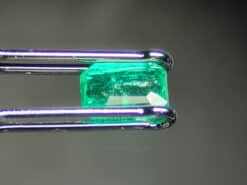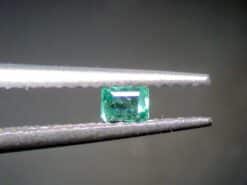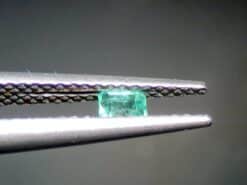lab created emeralds

What are synthetic hydrothermal emerald, lab created emeralds, man made emeralds?
Buy natural emerald in our shop
Hydrothermal synthetic emeralds have been attributed to IG Farben, Nacken, Tairus, and others, but the first satisfactory commercial product was that of Johann Lechleitner of Innsbruck, Austria, which appeared on the market in the 1960s.
These stones were initially sold under the names “Emerita” and “Symeralds”, and they were grown as a thin layer of emerald on top of natural colorless beryl stones.
Later, from 1965 to 1970, the Linde Division of Union Carbide produced completely synthetic emeralds, lab created or man made emeralds by hydrothermal synthesis. According to their patents (attributable to E.M. Flanigen), acidic conditions are essential to prevent the chromium (which is used as the colorant) from precipitating.
Also, it is important that the silicon-containing nutrient be kept away from the other ingredients to prevent nucleation and confine growth to the seed crystals. Growth occurs by a diffusion-reaction process, assisted by convection.
Lab created emeralds synthesis
Hydrothermal synthesis includes the various techniques of crystallizing substances from high-temperature aqueous solutions at high vapor pressures. The term hydrothermal is of geologic origin. Geochemists and mineralogists have studied hydrothermal phase equilibria since the beginning of the twentieth century.
George W. Morey at the Carnegie Institution and later, Percy W. Bridgman at Harvard University did much of the work to lay the foundations necessary to containment of reactive media in the temperature and pressure range where most of the hydrothermal work is conducted.
Producer
The largest producer of hydrothermal emeralds today is Tairus in Russia, which has succeeded in synthesizing stones with chemical composition similar to a real stone in alkaline deposits in Colombia, and whose products are thus known as “Colombian lab created emeralds” or “Tairus Created Emeralds”.
Luminescence in ultraviolet light is considered a supplementary test when making a natural vs. synthetic determination, as many, but not all, natural gems are inert to ultraviolet light. Many synthetics are also UV inert.
Created emerald or lab created emeralds
Synthetic are often referred to as “created”, as their chemical and gemological composition is the same as their natural counterparts. What can and what cannot be called “synthetic” stone:
It is unfair or deceptive to use the word “laboratory-grown,” “laboratory-created,” “created,” or “synthetic” with the name of any natural stone to describe any industry product unless such industry product has essentially the same optical, physical, and chemical properties as the stone named.
Synthetic hydrothermal emerald
FAQ
Are lab created worth anything?
Synthetic emeralds are some of the most expensive synthetic gems. The methods used to create them in labs require expensive equipment. Nevertheless, a lab-created emerald isn’t nearly as valuable as a natural emerald.
Are lab created stronger?
Emeralds are a 7.5 to 8 on the Mohs scale of hardness. While mined stones typically have filled fractures, this makes them less durable than other colored gemstones. While fake stones don’t have nearly as many fractures, they are more durable than mined, but you should still take care when wearing them.
Does lab created mean fake?
Stones created in a lab are chemically, physically and optically identical to those mined underground but they are fake.
How do you tell if an emerald is lab created?
A genuine emerald does not sparkle with fire, as do gemstones such as diamonds. If the stone does sparkle and have intense fire, it is likely a fake. Also, most fake stones are clean wile most natural stones are not.
What is synthetic emerald made of?
The synthesis of emeralds began in the 1930s with the Farben (Igmerald) and the Chatham processes. These were flux process synthetics, created by dissolving gem nutrients in a molten flux, and allowing crystallization on a seed of natural stone or Beryl.
How do you make a fake emerald?
Suspend a natural yellow beryl seed using a platinum wire to initiate growth. Add a solution of highly concentrated hydrochloric acid to prevent the chromophore (the part of a molecule that gives it its color) from precipitating. Wait 40 to 60 days for large crystals of synthetic emerald to form.
















